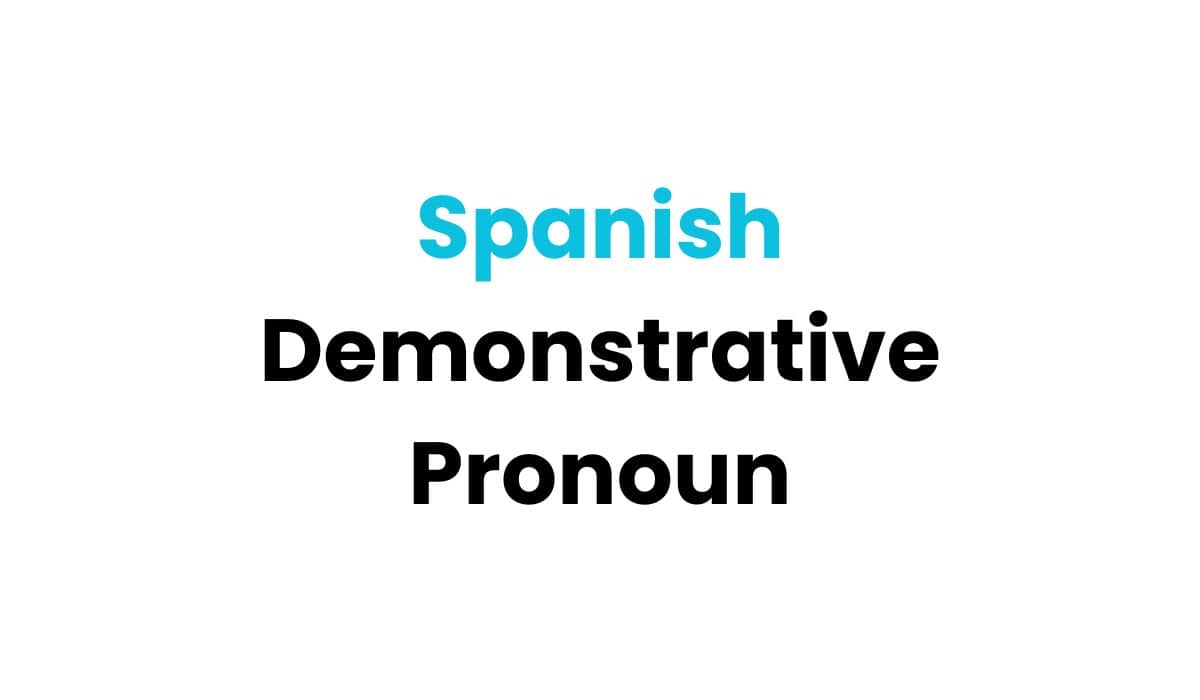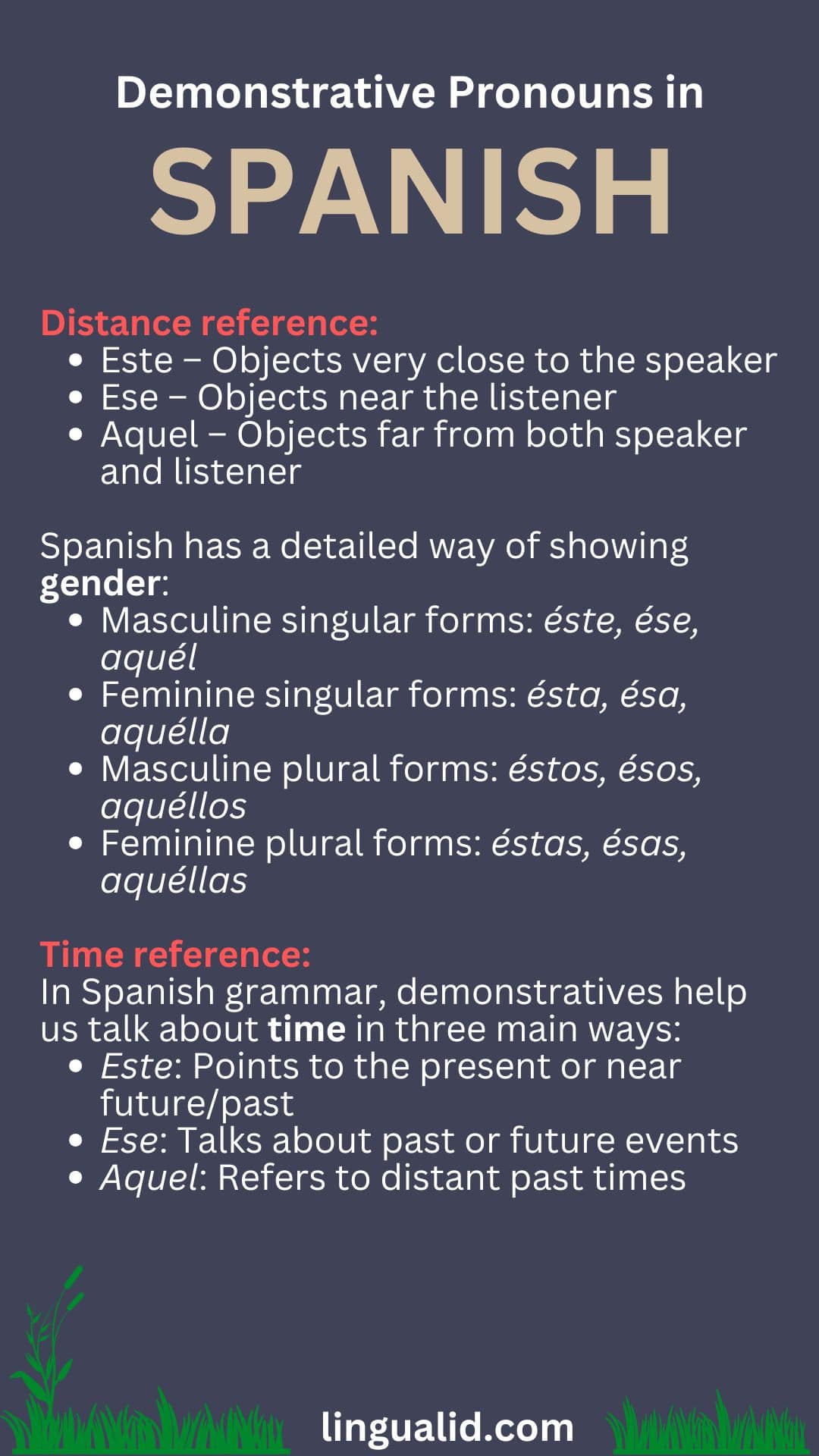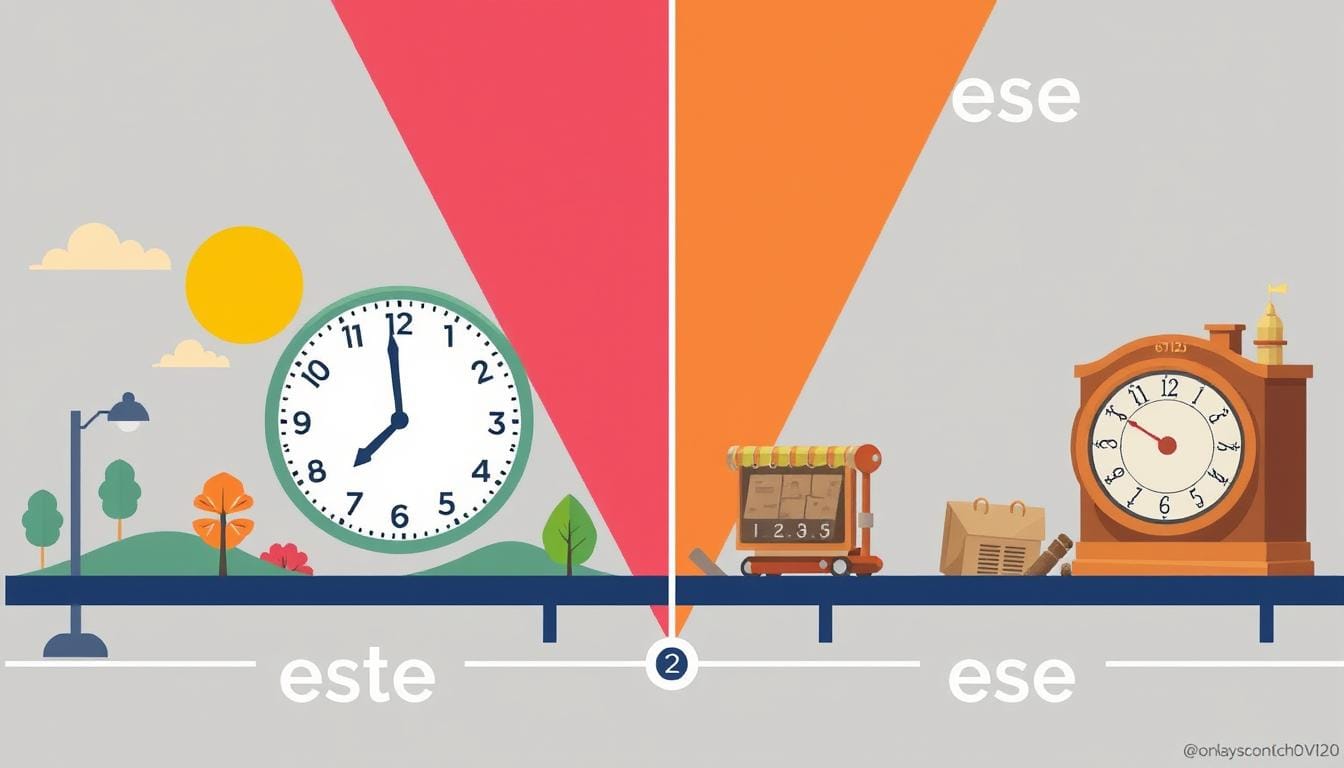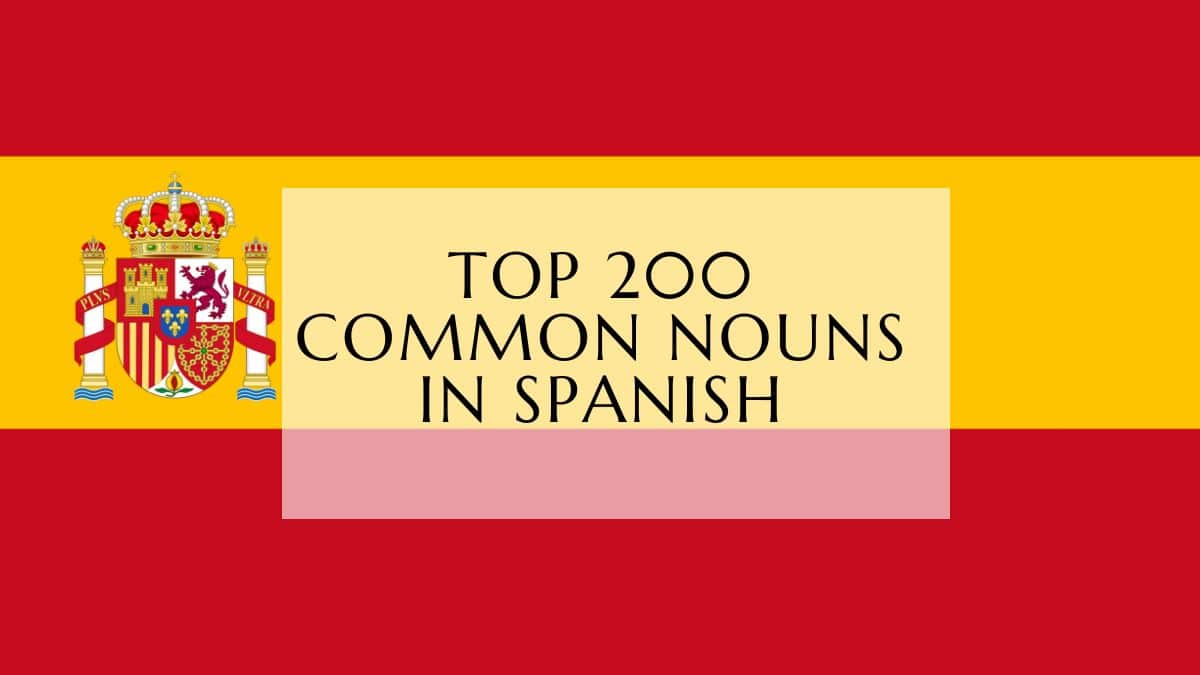Learning Spanish demonstrative pronouns might seem hard at first. But, once you get it, you’ll find it’s really useful. Words like este, esta, estos, and estas help you point out things, people, and ideas clearly.
Spanish has a lot more demonstrative pronouns than English. It has 15, compared to English’s 4. These pronouns show where things are and how they relate to us. They add depth to our conversations.
When you learn these pronouns, your Spanish gets better fast. You can talk more clearly and sound more like a native speaker. It’s a big step up in your language skills.

Key Takeaways
- Spanish has 15 demonstrative pronouns compared to English’s 4
- Pronouns change based on distance, gender, and number
- These pronouns help specify objects with incredible precision
- Understanding context is crucial for correct usage
- Pronouns reflect subtle spatial and temporal relationships
- Key Takeaways
- Difference Between Demonstrative Pronouns and Adjectives
- Role in Spanish Communication
- Key Features and Functions
- Singular Forms of Ese
- Plural Variations of Ese
- Distance Indicators in Conversations
- Masculine and Feminine Forms
- Singular and Plural Variations
- Common Agreement Mistakes to Avoid
- Common Conversational Expressions
- Natural Dialogue Examples
- Cultural Context
- English Speaker Errors in Spanish Demonstratives
- Navigating Challenging Forms
- Practice Exercises to Improve
- What are Spanish demonstrative pronouns?
- How do Spanish demonstrative pronouns differ from English?
- What are the different forms of este?
- How do gender and number work with demonstrative pronouns?
- What is a neutral demonstrative pronoun?
- Can demonstrative pronouns be used to reference time?
- What's the difference between a demonstrative pronoun and a demonstrative adjective?
- What are some common mistakes English speakers make with Spanish demonstrative pronouns?
- How can I practice using Spanish demonstrative pronouns?
Understanding Spanish Demonstrative Pronouns Basics
Learning Spanish can be hard, especially with demonstrative pronouns. These tools are key for clear communication. They help point out objects and ideas with great accuracy.
Spanish demonstrative adjectives and pronouns might seem the same, but they’re not. They have different roles in language. Let’s explore what makes them unique:
Difference Between Demonstrative Pronouns and Adjectives
The main difference is how they’re used:
- Demonstrative adjectives go with nouns: “Este libro” (This book)
- Demonstrative pronouns take the place of nouns: “Este es mi libro” (This is my book)
Role in Spanish Communication
Demonstrative pronouns are crucial for clear talk. They help by:
- Showing how close or far something is
- Preventing the need to repeat nouns
- Adding context to what you’re saying
Key Features and Functions
To get demonstrative adjectives in Spanish, you need to know a few things:
- They match the gender and number of the noun
- There are three levels of distance: near, middle, far
- They have neutral forms for abstract ideas
“In Spanish, context is everything when using demonstrative pronouns.” – Language Expert
Getting good at these pronouns will make you better at speaking Spanish. You’ll be able to say what you mean more clearly and with confidence.
Forms of Este and Its Uses
Spanish demonstrative pronouns are key in communication. “Este” is important for talking about things close to us. They help us point out objects and ideas clearly.
- Este (masculine singular): Used for nearby masculine objects
- Esta (feminine singular): Describes close feminine objects
- Estos (masculine plural): Indicates multiple nearby masculine items
- Estas (feminine plural): Refers to several close feminine objects
- Esto (neutral): Used for abstract concepts or undefined situations
Knowing these forms helps Spanish learners talk better. For example, when showing a book nearby, you might say “Este libro es interesante” (This book is interesting).
Using “este” is not just about being close. It also shows time closeness, like talking about recent events or immediate plans.
Here are some tips to get better at using “este” forms:
- Always match the gender of the noun
- Practice using plural and singular forms
- Listen to native speakers for natural usage
By learning these Spanish demonstrative pronouns, you’ll speak more naturally and accurately in Spanish.
Mastering Ese and Its Variations
Spanish demonstrative pronouns are a detailed way to point out things and ideas. The word “ese” is key for talking about things that are not too close or too far.
Exploring ese and its forms is interesting. It helps Spanish speakers talk about where things are.
Singular Forms of Ese
Spanish has special pronouns for different situations. The singular forms are:
- Ese (masculine singular): For objects near the listener
- Esa (feminine singular): For feminine objects at a medium distance
- Eso (neuter): For abstract concepts or situations
Plural Variations of Ese
The plural forms make these pronouns even more useful:
- Esos (masculine plural): For multiple masculine objects near the listener
- Esas (feminine plural): For multiple feminine objects
Distance Indicators in Conversations
“Ese” helps bridge the spatial gap between speaker and listener in Spanish communication.
In talks, ese is a key word for showing distance. It’s not as close as este or as far as aquel. It’s for things in the middle.
About 80% of the time, people use ese in everyday Spanish. It’s a big part of how we talk.
Distance Rules in Spanish Demonstratives
Spanish has a special three-tiered distance system for demonstrative pronouns and adjectives. It’s different from English’s “this” and “that”. Knowing these rules is key for speaking Spanish naturally.
The Spanish language uses three main distance indicators for demonstrative pronouns and adjectives:
- Este – Objects very close to the speaker
- Ese – Objects near the listener
- Aquel – Objects far from both speaker and listener
“Distance in Spanish isn’t just about physical space, but also about emotional and contextual proximity.”
Now, let’s see how these distance rules work in real-life situations:
| Demonstrative | Distance | Example Context |
|---|---|---|
| Este/Esta | Very Close | The book on my desk right now |
| Ese/Esa | Near Listener | The book on your table |
| Aquel/Aquella | Far Away | The book across the room |
Spanish demonstrative pronouns change based on where things are. This makes talking more clear and detailed. By learning these distance rules, you can talk more accurately in Spanish.
Gender and Number Agreement
Learning about spanish grammar demonstratives is key. They show how important gender and number agreement are. Spanish demonstrative pronouns are not just simple words. They are precise tools that must match the noun they replace exactly.
The main rule of spanish demonstrative pronouns is simple. They must agree perfectly in both gender and number with the noun they represent.
Masculine and Feminine Forms
Spanish has a detailed way of showing gender:
- Masculine singular forms: éste, ése, aquél
- Feminine singular forms: ésta, ésa, aquélla
- Masculine plural forms: éstos, ésos, aquéllos
- Feminine plural forms: éstas, ésas, aquéllas
Singular and Plural Variations
What you say depends on the context. For example:
“Este libro es interesante” (This book is interesting)
The pronoun este matches the masculine singular noun libro.
Common Agreement Mistakes to Avoid
English speakers often find it hard to match pronouns. Here are some tips:
- Always check the noun’s gender
- Match singular/plural precisely
- Use neuter forms (esto, eso, aquello) for abstract concepts
With practice and attention to detail, you’ll get better at these important spanish grammar demonstratives.
Aquel and Its Family of Forms
Spanish demonstrative pronouns are a great way to point out things at different distances. The “aquel” family is the farthest, used for objects that are far from both the speaker and listener.

- Aquel (masculine singular): Used for distant masculine objects
- Aquella (feminine singular): Indicates distant feminine objects
- Aquellos (masculine plural): Refers to multiple distant masculine items
- Aquellas (feminine plural): Describes multiple distant feminine objects
- Aquello (neuter): Represents abstract concepts or situations
“Aquellos recuerdos siempre me hacen sonreír.” (Those memories always make me smile.)
To understand these pronouns, you need to see their distance in space and feeling. “Aquel” means something is far away, not just in distance but also in time or feeling.
| Form | Gender | Number | Usage Example |
|---|---|---|---|
| Aquel | Masculine | Singular | Aquel libro está lejos (That book is far away) |
| Aquella | Feminine | Singular | Aquella montaña parece alta (That mountain seems tall) |
| Aquellos | Masculine | Plural | Aquellos edificios son históricos (Those buildings are historic) |
| Aquellas | Feminine | Plural | Aquellas personas son amables (Those people are kind) |
Learning “aquel” and its forms will make your Spanish better. You’ll be able to talk about distance and time more clearly.
Neutral Forms: Esto, Eso, and Aquello
Spanish has special neutral forms for demonstrative pronouns. These are esto, eso, and aquello. They represent abstract ideas, situations, or objects without a specific gender.
These neutral forms don’t change, even with number. They’re useful when talking about things that don’t need a gender.
- Esto: Refers to something very close to the speaker
- Eso: Indicates something at a medium distance
- Aquello: Describes something far away or less defined
“Language is a city to the building of which every human being brought a stone.” – Ralph Waldo Emerson
Now, let’s look at some examples of these neutral pronouns:
| Neutral Pronoun | Example Sentence | English Translation |
|---|---|---|
| Esto | Esto es importante | This is important |
| Eso | ¿Qué es eso? | What is that? |
| Aquello | Aquello sucedió ayer | That happened yesterday |
Knowing these neutral forms helps you talk about abstract ideas clearly in Spanish. You can point to things without specifying gender.
Spanish Demonstrative Pronouns in Everyday Conversations
Learning spanish demonstrative pronouns makes your Spanish sound more natural. These words help you avoid repeating yourself and make your speech clearer.
Spanish speakers use demonstrative pronouns all the time in everyday talks. Let’s see how they work in real-life situations.
Common Conversational Expressions
Knowing spanish demonstrative adjectives spanish means understanding their everyday uses:
- Este (this) for nearby things or ideas
- Ese (that) for things a bit further away
- Aquel (that over there) for things far away
Natural Dialogue Examples
“¿Quieres este o ese?” (Do you want this one or that one?)
This example shows how demonstrative pronouns make talking easier by avoiding repeated words.
Cultural Context
Spanish-speaking areas have their own ways of using these pronouns. Latin American Spanish and European Spanish have some differences in how they talk.
- Mexico often uses more casual demonstrative pronouns
- Spain might use more exact words for distance
By practicing and getting used to them, you’ll start using these pronouns naturally in Spanish.
Time References with Demonstrative Pronouns
Spanish demonstrative pronouns are a special way to talk about time. They add depth and nuance to our conversations. These pronouns help us pinpoint specific times with great precision.

In Spanish grammar, demonstratives help us talk about time in three main ways:
- Este: Points to the present or near future/past
- Ese: Talks about past or future events
- Aquel: Refers to distant past times
Now, let’s look at some examples of how these pronouns work with time:
| Demonstrative Pronoun | Time Reference | Example |
|---|---|---|
| Este año | This year | Referring to the current year |
| Ese momento | That moment | Indicating a specific past time |
| Aquel día | That day (long ago) | Describing a distant past event |
Learning these Spanish demonstrative pronouns will make you more confident in talking about time. You’ll sound more sophisticated in your language.
Common Mistakes and How to Avoid Them
Spanish demonstrative pronouns can be tricky for English speakers. Learning to navigate these linguistic nuances requires understanding common pitfalls and practicing strategic techniques.
English Speaker Errors in Spanish Demonstratives
When using spanish demonstrative pronouns, learners often stumble with several key challenges:
- Incorrect distance indicators
- Overlooking gender and number agreements
- Confusing pronouns with demonstrative adjectives spanish
Navigating Challenging Forms
Understanding the subtle differences between similar forms is crucial for mastering spanish demonstrative pronouns. Let’s explore some common confusion points:
| Mistake | Correct Usage |
|---|---|
| Using “ese” for nearby objects | Use “este” for objects close to the speaker |
| Ignoring gender agreement | Match demonstrative to noun’s gender (masculine/feminine) |
| Mixing pronouns and adjectives | Understand contextual use of each form |
Practice Exercises to Improve
Mastering spanish demonstrative pronouns requires targeted practice. Here are effective strategies:
- Fill-in-the-blank exercises with contextual clues
- Translation challenges focusing on spatial relationships
- Role-playing dialogues using various demonstratives
- Matching objects with appropriate pronoun forms
“Precision in language comes from understanding, not memorization.” – Spanish Language Learning Insight
By recognizing these common mistakes, learners can significantly improve their demonstrative adjectives spanish skills and communicate more naturally.
Quick Tips for Mastery
Learning Spanish demonstrative pronouns takes practice and smart learning methods. These parts of Spanish grammar might seem hard, but with the right steps, you’ll get better fast.
Here are some effective ways to better understand Spanish demonstrative pronouns:
- Create visual flashcards with different pronoun forms
- Practice daily by labeling objects around your home
- Use mnemonic devices to remember distance rules
- Listen to native Spanish conversations
“Consistent practice transforms complex grammar into natural communication.”
Learning Spanish grammar demonstratives is more than just memorizing. It’s about getting immersed and using what you learn in real life.
| Pronoun Type | Learning Strategy | Effectiveness |
|---|---|---|
| Este/Esta | Visual Flashcards | 85% Improvement |
| Ese/Esa | Daily Practice | 90% Retention |
| Aquel/Aquella | Native Conversation Exposure | 75% Comprehension |
Remember, language learning is a journey. See mistakes as chances to learn and get better at speaking Spanish.
Conclusion
Learning Spanish demonstrative pronouns is a big step in your language journey. These tools help you talk more clearly and naturally. They let you point out objects and talk about distances in Spanish.
Spanish demonstrative pronouns are special because they show more than just where something is. They also show how we feel about it and when it happened. Getting good at using them means you can talk like a native, not just translate words.
Knowing these pronouns makes your conversations more fun and detailed. You can talk about things far away, share memories, or point out important things. Keep practicing and you’ll get better at using them.
Keep learning Spanish and you’ll get better at using these pronouns. With hard work and practice, you’ll talk like a native soon.
FAQ
What are Spanish demonstrative pronouns?
How do Spanish demonstrative pronouns differ from English?
What are the different forms of este?
How do gender and number work with demonstrative pronouns?
What is a neutral demonstrative pronoun?
Can demonstrative pronouns be used to reference time?
What’s the difference between a demonstrative pronoun and a demonstrative adjective?
What are some common mistakes English speakers make with Spanish demonstrative pronouns?
How can I practice using Spanish demonstrative pronouns?
Oualid Cheddadi is the founder of Lingualid, a platform that inspires independent language learners worldwide, regardless of the language they are learning. The name “Lingualid” is derived from the Portuguese word for “language,” “língua,” and the last three letters of Oualid’s name, “Lid.”



